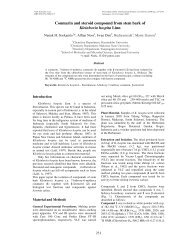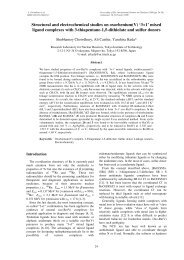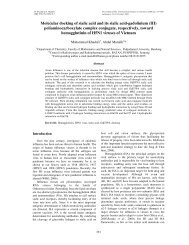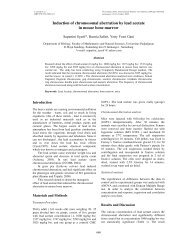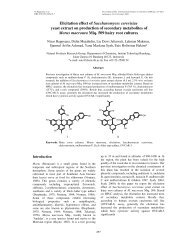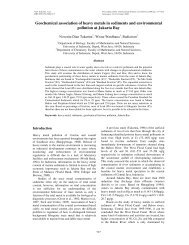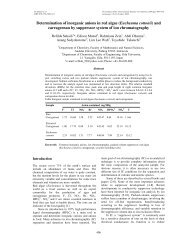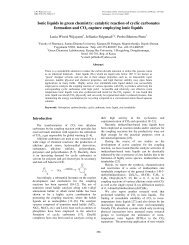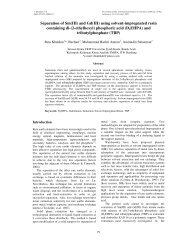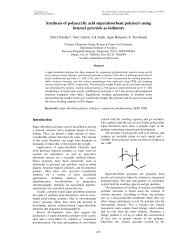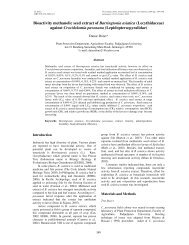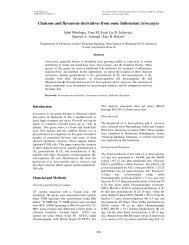Ethanol extract of Mahkota Dewa (Phaleria macrocarpa (Scheff ...
Ethanol extract of Mahkota Dewa (Phaleria macrocarpa (Scheff ...
Ethanol extract of Mahkota Dewa (Phaleria macrocarpa (Scheff ...
- No tags were found...
Create successful ePaper yourself
Turn your PDF publications into a flip-book with our unique Google optimized e-Paper software.
I.H. Suparto et al. Proceeding <strong>of</strong> The International Seminar on Chemistry 2008 (pp. 285-288)ISBN 978-979-18962-0-7Jatinangor, 30-31 October 2008<strong>Ethanol</strong> <strong>extract</strong> <strong>of</strong> <strong>Mahkota</strong> <strong>Dewa</strong> (<strong>Phaleria</strong> <strong>macrocarpa</strong> (<strong>Scheff</strong>,) Boerl.)fruit with in-vitro antidiabetic activitiesIrma H. Suparto 1,2,3 *, Nurhikmah Arfianti 1 , Tri Septiawati 1 ,Wulan Triwahyuni 1,2 , Diah Iskandriati 31 Department <strong>of</strong> Chemistry, Faculty <strong>of</strong> Mathematics and Natural Sciences,Institut Pertanian Bogor, Bogor, West Java, Indonesia,2 Biopharmaca Research Center, Institut Pertanian Bogor, Bogor, West Java, Indonesia3 Primate Research Center, Institut Pertanian Bogor, Bogor, West Java, Indonesia*e-mail: irma.suparto@yahoo.comAbstract<strong>Mahkota</strong> dewa (<strong>Phaleria</strong> <strong>macrocarpa</strong>) fruit is popular in Indonesia used as an alternative ortraditional medicine especially for antidiabetic. However, its mechanism and compound asantidiabetic has not been further studied yet. Therefore, the objective <strong>of</strong> this research is to elucidateits mechanism <strong>of</strong> action as insulin secretagog in clonal glucose responsive insulin secreting cellsBRIN-BD11 and α-glucosidase inhibitor in-vitro. The <strong>extract</strong> was further analyzed to determine itsactive compound. <strong>Mahkota</strong> dewa’s fruits were <strong>extract</strong>ed by maceration method with ethanol 30% assolvent. The ethanol <strong>extract</strong> contains phytochemical alkaloid, flavonoid, tannin, and steroid. Insulinsecretory responds after one hour incubation in 16.7 mM glucose media with concentration <strong>of</strong> 1.12,2.25, and 4.50 mg/ml mahkota dewa fruit <strong>extract</strong> showed 1.5, 1.3, and 2.0 folds increased comparedto control. However, almost the same respond compared to glibenclamide, which is an insulinsecretagog drug. In-vitro assay for α-glucosidase inhibitory activity was measured based on theformation <strong>of</strong> p-nitrophenol (yellow solution) through hydrolysis <strong>of</strong> substrate p-nitrophenyl α-Dglucopiranoside.The concentration <strong>of</strong> the <strong>extract</strong> were 1%, 1.5%, and 2% resulted inhibition levelrespectively 26.40%, 29.22%, and 24.51%, which was very low compared to acarbose (99%), an α-glucosidase inhibitor. The <strong>extract</strong> was further analyzed with flash chromatography, thin layerchromatography, and reconfirmed with phytochemical assay which contains flavonoid compound.Keywords: α-glucosidase inhibitor, flavonoid, insulin secretagogIntroductionDiabetes mellitus is a condition or disease causedby deficiency in insulin. The characteristic <strong>of</strong> thisdisease is high blood glucose concentration orhyperglycemia. World Health Organization (WHO)reported that in 2025 there will be an estimation <strong>of</strong>300 millions people in the world suffered diabetes. In2005, Indonesia was rank 4 th in the world andcontinues to increase to 12.4 millions people in theyear 2025 (Department <strong>of</strong> Health 2005).It is necessary to find new approaches for cure andprevention <strong>of</strong> this disease that is affordable for thepeople. Several mechanisms for oral antidiabetic areinsulin secretagog that stimulate pancreas to secreteinsulin and α-glucosidase inhibitors that block theenzyme α-glucosidase in the brush borders <strong>of</strong> thesmall intestines, which delays absorption <strong>of</strong>carbohydrates (Fonseca & Kulkarni 2008; Asano2003). Efforts in finding cure with using herbal plantshad been pursued for many years. However, WHOhad recommended that traditional plant therapy fordiabetes need further evaluation (WHO 1980).<strong>Mahkota</strong> dewa (<strong>Phaleria</strong> <strong>macrocarpa</strong>) is amember <strong>of</strong> the Thymelaeaceae family. It has beenreported that this plant has several medicinalproperties including the ability to lower bloodpressure, to cure hepatitis, to increase stamina, to treatcancer and to lower blood glucose (Harmanto 2003;Winarto 2003).Empirically, the fruit <strong>of</strong> mahkota dewa (<strong>Phaleria</strong><strong>macrocarpa</strong>) believed to reduce blood glucose andhad been shown in a preliminary study using diabeticinduced-streptozotocin rats. The water <strong>extract</strong>ed fruit<strong>of</strong> mahkota dewa reduced 46% <strong>of</strong> the blood glucosecompared to its control group with dosage <strong>of</strong> 32.1mg/kg body weight (Shalahuddin et al. 2005).However, its mechanism and the phytochemicalcompound as antidiabetic still unknown. Therefore, inthis study, the goal is to understand the phytochemicalcompound and the in vitro mechanism <strong>of</strong> the ethanol<strong>extract</strong> <strong>of</strong> mahkota dewa fruits as insulin secretagog inpancreatic cell culture BRIN-BD11 and as α-glucosidase inhibitor.Materials and MethodsReagentsα-Glucosidase <strong>of</strong> Bacillus stearothermophylus(Sigma-Aldrich, USA), p-nitrophenyl-α-Dglucopyranocide(Sigma-Aldrich USA), bovine serumalbumin (Merck-Darmstadt), Na 2 CO 3 , acarbose(Bayer, Indonesia), rat insulin ELISA (Mercodia,285
I.H. Suparto et al. Proceeding <strong>of</strong> The International Seminar on Chemistry 2008 (pp. 290-293)Jatinangor, 30-31 October 2008Sweden), RPMI medium, Kreb Ringer’s Buffer andHepes.Preparation <strong>of</strong> ethanol <strong>extract</strong>Ripe fruit <strong>of</strong> mahkota dewa (Macrocarpaphaleria) that has dark pink with slight green streaksfrom the product <strong>of</strong> Faculty <strong>of</strong> Forestry BogorAgricultural University Indonesia were sliced thinly,dried in oven (50 o C) for 30 hours and made intopowder. The powder was <strong>extract</strong>ed with ethanol 30%with maceration techniques for three days then, driedusing rotary evaporator.Qualitative identification <strong>of</strong> phytochemical compoundPhytochemical qualitative assay <strong>of</strong> the ethanol<strong>extract</strong> <strong>of</strong> mahkota dewa fruit was performedaccording to the method described by Harborne(1987) for flavonoid, alkaloid, saponin, tannin,triterpenoid, and steroid compound.α-Glucosidase inhibitor activity in vitroα-Glucosidase inhibitor activity was determinedusing modified method by Watanabe et al. 1997.Extracted sample was dissolved in dimethylsulfoxide(DMSO) at a concentration <strong>of</strong> 1% 1.5% and 2%.Enzyme 1.0 mg α-glucosidase dissolved in 100 mMphosphate buffer (pH 7) containing 200 mg bovineserum albumin. Mixed solution consisted <strong>of</strong> 250 µl p-nitrophenyl-α-D-glucopyranoside (p-NPG) 200 mMas substrate, 490 µl phosphate buffer (pH 7) 100 mM,and 10 µl sample in DMSO1%. This mixture wasincubated at 37 o C for 5 minutes, added 250 µl enzymesolution then additional 15 minutes incubation.Reaction was stopped with the addition <strong>of</strong> 1000 µlsodium carbonate (Na 2 CO 3 ) 200 mM. The activitywas measured with spectrophotometer at λ 400 nm.Positive control was acarbose tablet in phosphatebuffer (pH 7) and HCl 2N with standard concentration<strong>of</strong> 1%.Insulin secretagog in vitroCell culture BRIN-BD11, a glucose-responsiveclonal insulin-secreting cell line, produced by electr<strong>of</strong>usion <strong>of</strong> immortal RINm5F cell with New EnglandDeaconess Hospital rat pancreatic B-cell, was used toevaluate insulin secretion (McClenaghan et al. 1996,Gray & Flatt 1997). This cell culture used forscreening <strong>of</strong> antidiabetic plant materials andcharacterization <strong>of</strong> novel insulin-releasing naturalproducts has been described elsewhere (Gray & Flatt1997a,b 1998). Cells were seeded at a concentration<strong>of</strong> 2x10 6 cells/well in 24-well plates (Falcon, NJ,USA) cultured in RPMI-1640 containing 11·1 mMglucose, 10% fetal calf serum and antibiotics (50.000IU/l penicillin–streptomycin) to allow attachmentovernight prior to acute tests. Cells were washed threetimes with Kreb’s–Ringer bicarbonate buffer (KRB;115 mM NaCl, 4.7 mM KCl, 1.3 mM CaCl2, 1.2 mMKH 2 PO 4 , 1.2 mM MgSO 4 , 24 mM NaHCO 3 , 10 mMHepes-free acid, 1 g/l bovine serum albumin, 1,1 mMglucose; pH 7·4) and preincubated for 40 min at 37 o C.Cells were then incubated for 20 min with 1 ml KRBat 1.1 mM glucose or 60 min in KRB 16.7 mM in theabsence and presence <strong>of</strong> plant <strong>extract</strong>. Followingincubation, aliquots were removed from each well andstored at 20 o C for insulin assay (Flatt & Bailey 1981).Flash chromatography <strong>of</strong> the <strong>extract</strong>Fractionation <strong>of</strong> the crude <strong>extract</strong>s using flashchromatography with the velocity <strong>of</strong> 10 mL/min. Theeluent used was mixture <strong>of</strong> butanol:acetate acid:waterwith ratio 60:15:25. Those fractions were furthercollected into one fraction based on the Rf value withthe thin layer chromatography then identified by UVspectrophotometer.Results and DiscussionPhytochemical compoundThe phytochemical compound <strong>of</strong> the ethanol<strong>extract</strong> <strong>of</strong> mahkota dewa fruit consist <strong>of</strong> alkaloid,flavonoid, tannin and steroid. This finding wasdifferent compared to Wulandari (2005) andShalahuddin (2005). They reported that it also containsaponin. Phytochemical compound is a secondarymetabolite which is affected by geographical andmicronutrient <strong>of</strong> the soil (Kardono 2003)α-Glucosidase inhibitor activity in vitroThe inhibitory activity <strong>of</strong> the ethanol <strong>extract</strong> <strong>of</strong>mahkota dewa fruits is shown in Figure 1. Theinhibitory activity in the concentration <strong>of</strong> 1%, 1.5%,and 2% were 26.48%, 29.22%, dan 24.51%,respectively. The positive control, acarbose 1% had99.34% inhibitory activity against α-glucosidase .However, the inhibitory activity <strong>of</strong> the methanol<strong>extract</strong> <strong>of</strong> mahkota dewa fruits with concentration <strong>of</strong>1% were 40.9% which is higher compared to theethanol <strong>extract</strong> (Rohimah 2008). Mai and Chuyen(2007) reported that Sophora japonica, Nelumbonucifera, Psidium guajava, Camellia sinensis andCleistocalyx operculatus with concentration 20 mg/mlhad inhibitory activity respectively 47.5%, 51.4%,60.8%, 65.4%, and 68.2%.α-Glucosidase is an important enzyme forcarbohydrate in the small intestine which controls thepost-prandial blood glucose concentration (Mooradian& Thurman 1999; Fonseca & Kulkarni 2008).Synthetic α-glucosidase inhibitory agent, acarbose hasmore side effects such as flatulence and diarrhea(Mooradian & Thurman 1999), therefore, naturalproduct is hoped to have less side effect. The lowerinhibitory effect <strong>of</strong> mahkota dewa fruit <strong>extract</strong> ispotential to be used as antidiabetic but need furtherevidence through in vivo study.286
I.H. Suparto et al. Proceeding <strong>of</strong> The International Seminar on Chemistry 2008 (pp. 290-293)Jatinangor, 30-31 October 2008% inhibition1209060309926.48 29.2224.51performed using thin layer chromatography that resultfour fractions. Identification <strong>of</strong> the fractions withphytochemical assays and spectrophotometerultraviolet (wavelength 259-260) suggesting <strong>of</strong>flavonoid compound (Harborne 1987).Conclusions0Acarbose1%1.0% 1.5% 2.0%Concentration (%)Figure 1 α-Glucosidase inhibitory activities <strong>of</strong>ethanol <strong>extract</strong> <strong>of</strong> mahkota dewa fruit withconcentration <strong>of</strong> 1.0%, 1.5%, and 2%, withpositive control, acarbose 1%Insulin secretagog in vitro<strong>Ethanol</strong> <strong>extract</strong> <strong>of</strong> mahkota dewa fruits with variedconcentration showed stimulatory effect on insulinsecretagog in cell culture <strong>of</strong> BRIN-BD11 with 16.7mM glucose with 60 min incubation compared to the20 min incubation (Table 1).Table 1 Effect <strong>of</strong> ethanol <strong>extract</strong> <strong>of</strong> mahkota dewafruits on insulin secretion at 1.11mM glucose(A), 16.7 mM glucose at 20 min (B) and 16.7mM glucose at 60 min (C).Extractconcentration(mg/ml) AInsulin secretion(µg/l/3x10 5 cells)B C0 0.262 0.180 0.2531.125 0.210 0.200 0.3802.250 0.237 0.276 0.3324.500 0.250 0.290 0.506The insulin secretion for concentration <strong>of</strong>1.125mg/ml, 2.250 mg/ml and 4.500 mg/ml was 1.5fold, 1.3 fold, and 2 folds respectively compared tocontrol. The increased response is only for the 60 minincubation in the present <strong>of</strong> higher glucoseconcentration (16.7 mM) which represent the secondphase <strong>of</strong> biphasic insulin secretion (Mears & Atwater2000). However, the 20 min incubation (as the firstphase) showed no response. This result showed thatmahkota dewa ethanol <strong>extract</strong> had lower insulinsecretion response compared to sambiloto with 3.7fold increased for concentration <strong>of</strong> 2.5 mg/ml (Wibudi2006).Flash chromatography <strong>of</strong> the <strong>extract</strong>Fractionation <strong>of</strong> the ethanol <strong>extract</strong> <strong>of</strong> mahkotadewa fruit was processed with flash chromatography.The separation <strong>of</strong> compound with mixture <strong>of</strong>butanol:acetate acid:water in the ratio <strong>of</strong> 60:15:25 thatshowed optimal result. Further separation was<strong>Ethanol</strong> <strong>extract</strong> <strong>of</strong> mahkota dewa fruit has in vitroα-glucosidase inhibitor activities and insulinsecretagog. The phytochemical compound thatshowed activities as antidiabetic was suggested as theflavonoid compound. However it needs furtherexploration.AcknowledgementsOur appreciation to DR. dr. Aris Wibudi GatotSubroto Hospital, Jakarta and Pr<strong>of</strong>. André Herchuelz,Laboratoire de Pharmacodynamie et deThérapeutique, Université Libre de Bruxelles, Facultéde Médecine, Bruxelles, Belgium for sharing thepancreatic cell culture BRIN-BD11. This study waspartly financed by the Research Technology 2008Fund.ReferencesAsano N. 2003. Glycosidase inhibitors: update andperspectives on practical use. Glycobiology13:93R-104RDepartment <strong>of</strong> Health. 2005. Jumlah PenderitaDiabetes Indonesia Ranking ke-4 di Dunia.http://www.depkes.go.id/index.php. [7 Januari2008]Flatt PR & Bailey CJ. 1981 Abnormal plasma glucoseand insulin responses in heterozygous lean (ob/+)mice. Diabetologia 20 573–577.Fonseca VA & Kulkarni KD. 2008. Management <strong>of</strong>type 2 diabetes: Oral agents, insulin, andinjectables. J Am Diet Assoc. 108:S29-S33.Gray AM & Flatt PR. 1997 Pancreatic and extrapancreaticeffects <strong>of</strong> the traditional anti-diabeticplant, Medicago sativa (lucerne). Brit J Nutr 78325–334.Harborne JB. 1987. Metode fitokimia, penuntun caramodern menganalisis tumbuhan. Bandung:Penerbit ITB.Harmanto N. 2003. <strong>Mahkota</strong> dewa, Obat pusaka paradewa. Jakarta: PT. Agromedika Pustaka.Kardono LBS. 2003. Kajian kandungan kimiamahkota dewa (<strong>Phaleria</strong> <strong>macrocarpa</strong>) dalamProsiding seminar sehari mahkota dewa. Depkes:Puslitbang farmasi dan obat tradisional BadanPenelitian dan Pengembangan Kesehatan.287



